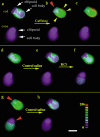Ryanodine stores and calcium regulation in the inner segments of salamander rods and cones
- PMID: 12562925
- PMCID: PMC2342740
- DOI: 10.1113/jphysiol.2002.035683
Ryanodine stores and calcium regulation in the inner segments of salamander rods and cones
Abstract
Despite the prominent role played by intracellular Ca2+ stores in the regulation of neuronal Ca2+ homeostasis and in invertebrate photoreception, little is known about their contribution to the control of free Ca2+ concentration ([Ca2+]i) in the inner segments of vertebrate photoreceptors. Previously, caffeine-sensitive intracellular Ca2+ stores were shown to play a role in regulating glutamate release from photoreceptors. To understand the properties of these intracellular stores better we used pharmacological approaches that alter the dynamics of storage and release of Ca2+ from intracellular compartments. Caffeine evoked readily discernible changes in [Ca2+]i in the inner segments of rods, but not cones. Caffeine-evoked Ca2+ responses in cone inner segments were unmasked in the presence of inhibitors of the plasma membrane Ca2+ ATPases (PMCAs) and mitochondrial Ca2+ sequestration. Caffeine-evoked responses were blocked by ryanodine, a selective blocker of Ca2+ release and by cyclopiazonic acid, a blocker of Ca2+ sequestration into the endoplasmic reticulum. These two inhibitors also substantially reduced the amplitude of depolarization-evoked [Ca2+]i increases, providing evidence for Ca2+-induced Ca2+ release (CICR) in rods and cones. The magnitude and kinetics of caffeine-evoked Ca2+ elevation depended on the basal [Ca2+]i, PMCA activity and on mitochondrial function. These results reveal an intimate interaction between the endoplasmic reticulum, voltage-gated Ca2+ channels, PMCAs and mitochondrial Ca2+ stores in photoreceptor inner segments, and suggest a role for CICR in the regulation of synaptic transmission.
Figures











Similar articles
-
Spatiotemporal regulation of ATP and Ca2+ dynamics in vertebrate rod and cone ribbon synapses.Mol Vis. 2007 Jun 15;13:887-919. Mol Vis. 2007. PMID: 17653034 Free PMC article.
-
Release and sequestration of calcium by ryanodine-sensitive stores in rat hippocampal neurones.J Physiol. 1997 Jul 1;502 ( Pt 1)(Pt 1):13-30. doi: 10.1111/j.1469-7793.1997.013bl.x. J Physiol. 1997. PMID: 9234194 Free PMC article.
-
Ca2+ Diffusion through Endoplasmic Reticulum Supports Elevated Intraterminal Ca2+ Levels Needed to Sustain Synaptic Release from Rods in Darkness.J Neurosci. 2015 Aug 12;35(32):11364-73. doi: 10.1523/JNEUROSCI.0754-15.2015. J Neurosci. 2015. PMID: 26269643 Free PMC article.
-
Calcium regulation in photoreceptors.Front Biosci. 2002 Sep 1;7:d2023-44. doi: 10.2741/A896. Front Biosci. 2002. PMID: 12161344 Free PMC article. Review.
-
Interplay between ER Ca2+ uptake and release fluxes in neurons and its impact on [Ca2+] dynamics.Biol Res. 2004;37(4):665-74. doi: 10.4067/s0716-97602004000400024. Biol Res. 2004. PMID: 15709696 Review.
Cited by
-
Calcium homeostasis and cone signaling are regulated by interactions between calcium stores and plasma membrane ion channels.PLoS One. 2009 Aug 21;4(8):e6723. doi: 10.1371/journal.pone.0006723. PLoS One. 2009. PMID: 19696927 Free PMC article.
-
Serca isoform expression in the mammalian retina.Exp Eye Res. 2005 Dec;81(6):690-9. doi: 10.1016/j.exer.2005.04.007. Epub 2005 Jun 20. Exp Eye Res. 2005. PMID: 15967430 Free PMC article.
-
Synaptic Ribbon Active Zones in Cone Photoreceptors Operate Independently from One Another.Front Cell Neurosci. 2017 Jul 11;11:198. doi: 10.3389/fncel.2017.00198. eCollection 2017. Front Cell Neurosci. 2017. PMID: 28744203 Free PMC article.
-
Retinal TRP channels: Cell-type-specific regulators of retinal homeostasis and multimodal integration.Prog Retin Eye Res. 2023 Jan;92:101114. doi: 10.1016/j.preteyeres.2022.101114. Epub 2022 Sep 24. Prog Retin Eye Res. 2023. PMID: 36163161 Free PMC article. Review.
-
The Interplay between Neurotransmitters and Calcium Dynamics in Retinal Synapses during Development, Health, and Disease.Int J Mol Sci. 2024 Feb 13;25(4):2226. doi: 10.3390/ijms25042226. Int J Mol Sci. 2024. PMID: 38396913 Free PMC article. Review.
References
-
- Baumann O, Walz B. Endoplasmic reticulum of animal cells and its organization into structural and functional domains. Int Rev Cytol. 2001;205:149–214. - PubMed
-
- Berger ER. Subsurface membranes in paired cone photoreceptor inner segments of adult and neonatal Lebistes retinae. J Ultrastruct Res. 1967;17:220–232. - PubMed
-
- Berridge MJ, Lipp P, Bootman MD. The versatility and universality of calcium signalling. Nat Rev Mol Cell Biol. 2000;1:11–21. - PubMed
Publication types
MeSH terms
Substances
Grants and funding
LinkOut - more resources
Full Text Sources
Miscellaneous

